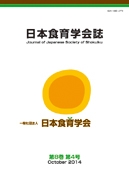
- 4 号 p. 157-
- 3 号 p. 121-
- 2 号 p. 71-
- 1 号 p. 15-
- |<
- <
- 1
- >
- >|
-
—食のライフスタイルと食品廃棄行動の関連から—佐藤 みずほ, 水山 元2022 年 16 巻 4 号 p. 157-173
発行日: 2022/10/25
公開日: 2022/11/08
ジャーナル フリーA large amount of food is wasted in Japan, especially after they are purchased by consumers. Unfortunately, a larger amount is also wasted pre-purchase. How this waste occurs depends largely on consumer behavior, thus it is important to consider food waste reduction from the perspective of consumers. To facilitate this consideration, this study classifies consumers according to their food lifestyle and food consumption behavior in relation to food waste before characterizing each segment in both classifications and analyzing their relations. This study uses the “Food-Related Lifestyle: FRL” analysis proposed by Grunert for segmenting the former, and newly develops a structured questionnaire “Food Waste Behavior: FWB” for the latter. From our results, consumers can be classified into 6 FRL-segments and 4 FWB-segments. Some FRL-segments obtained in this study were also found in Grunert’s study, but new Japanese consumer-specific segments were also identified. By characterizing FWB-segments, it is suggested that improving cooking skills is effective in reducing food waste. Analyzing the relations between FWB and FRL segments revealed that FWB-Segment 4 “Frequent Home Delivery Users Without Worrying About Food Waste” has the highest average score for the factor of “food waste” while most consumers in this FWB-segment belonged to FRL-segment 1 “Uninterested in Food.” Thus, food waste reduction measures should be primarily focused on the intersection of these segments. Both FWB and FRL approaches were effective in devising food waste reduction measures. Concrete actions include encouraging organizations such as companies and schools to implement educational programs on food waste issues, developing and certifying human resources capable of conducting such education, and holding competition events for effective gamification related to food waste reduction. We should also certify and commend excellent industrial cases and add them to a database.
抄録全体を表示PDF形式でダウンロード (2977K) -
細井 菜穂子, 村上 智美, 太田 雅規2022 年 16 巻 4 号 p. 175-182
発行日: 2022/10/25
公開日: 2022/11/08
ジャーナル フリーThis study investigated the effects of an individual’s economic status and frequency of eating with adults and at-home meal preparation while in junior high school on his/her vegetable intake frequency in adulthood. We selected men and women aged 20-49 years via an internet survey. The survey comprised data on participants’ current height and weight; weight at 20 years of age; economic status, frequency of eating with adults, and frequency of at-home meal preparation while in junior high school; and current vegetable intake frequency. The current vegetable intake frequency was significantly higher among individuals who were wealthier while in junior high school than among their poorer counterparts (OR: 2.56 [95% CI: 1.53-4.31], p=0.0004, p for trend=0.0003). Individuals who ate breakfast with an adult and those who prepared meals at home more frequently when in junior high school had a significantly higher current vegetable intake frequency ([eating with adults] OR: 1.89 [95% CI: 1.31-2.71], p=0.001, p for trend=0.001 [at-home meal preparation] OR: 4.71 [95% CI: 2.69-8.24], p<0.0001, p for trend <0.0001). Thus, eating breakfast with adults and at-home meal preparation during junior high school was associated with higher current vegetable intake frequency, independent of the economic status during junior high school.
抄録全体を表示PDF形式でダウンロード (866K)
-
—「広島県『食に関する指導実績調査』」の解析から—塩田 良子, 鈴木 麻希, 熊谷 陽子, 門戸 千幸, 遠藤(山岡) 雅子, 杉山 寿美2022 年 16 巻 4 号 p. 183-195
発行日: 2022/10/25
公開日: 2022/11/08
ジャーナル フリーThe “Dietary Education Implementation Survey” published by the Hiroshima Prefecture Board of Education was analyzed to determine the grade level, teaching units, and contents of food education in which nutrition teachers taught integrated studies and dietary education in special activities. The results showed that topics of inquiry in integrated studies commonly addressed either “local cuisine and local products” in ‘topics related to the characteristics of the community or school such as lifestyles, traditions, and cultures of people in the local community’ or “experiencing cultivation and harvesting” in ‘topics based on the interests of school children.’ The focus for both was most often food and culture. As for dietary education in special activities, “food and nutrition” was taught frequently in ‘adaptation to daily life and learning, personal growth, and health and safety,’ often focusing on mental and physical health. In Grade 1 and Grade 7, “school lunch,” a teaching unit for ‘establishing classroom and school life routines,’ was frequently taught. This study revealed that nutrition teachers taught integrated studies and dietary education in special activities by means of cross-curricular instruction using teaching units that made the most of the characteristics of each subject and by establishing the contents of food education.
抄録全体を表示PDF形式でダウンロード (724K)
- |<
- <
- 1
- >
- >|